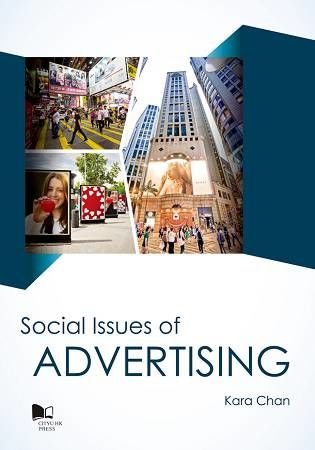Advertising is something which we are exposed to from a young age and which can affect us in many different ways. Centered around the question “Does advertising improve society?” this volume explores the impact and issues of advertising and questions its social responsibility, with a focus on Hong Kong society. The collection of essays offers a broad view of the interaction between society and advertising, from an introduction to semiotic studies, exploring the use of gender stereotypes to the employment of brand placement as a new form of product promotion.
Written by professors of advertising with experience from both within the industry and from international research, this is a senior level textbook designed to augment any studies in advertising, marketing, public relations or media studies.
| FindBook |
有 4 項符合
Social Issues of Advertising的圖書 |
 |
Social Issues of Advertising 出版社:香港城市大學 出版日期:2016-12-01 語言:英文 規格:平裝 / 240頁 / 17.5 x 25.2 cm / 普通級/ 單色印刷 / 再版 |
| 圖書館借閱 |
| 國家圖書館 | 全國圖書書目資訊網 | 國立公共資訊圖書館 | 電子書服務平台 | MetaCat 跨館整合查詢 |
| 臺北市立圖書館 | 新北市立圖書館 | 基隆市公共圖書館 | 桃園市立圖書館 | 新竹縣公共圖書館 |
| 苗栗縣立圖書館 | 臺中市立圖書館 | 彰化縣公共圖書館 | 南投縣文化局 | 雲林縣公共圖書館 |
| 嘉義縣圖書館 | 臺南市立圖書館 | 高雄市立圖書館 | 屏東縣公共圖書館 | 宜蘭縣公共圖書館 |
| 花蓮縣文化局 | 臺東縣文化處 |
|
|
圖書介紹 - 資料來源:博客來 評分:
圖書名稱:Social Issues of Advertising
內容簡介
作者介紹
作者簡介
Kara Chan
Kara Chan (PhD, City University of Hong Kong) is a Professor at the School of Communication, Hong Kong Baptist University. She worked in the advertising business and as a statistician for the Hong Kong Government before she moved into academia. Her research areas are cross-cultural consumer studies and health communication. She has published seven books as well as over 140 journal articles and book chapters. She was a Fulbright scholar at Bradley University, Illinois as well as a Visiting Professor at Copenhagen Business School, Aarhus University and Klagenfurt University. Her journal articles have won five Emerald Literati Network Awards for Excellence. She received awards for Outstanding Performance in Scholarly Work at Hong Kong Baptist University in 2006 and 2014.
Kara Chan
Kara Chan (PhD, City University of Hong Kong) is a Professor at the School of Communication, Hong Kong Baptist University. She worked in the advertising business and as a statistician for the Hong Kong Government before she moved into academia. Her research areas are cross-cultural consumer studies and health communication. She has published seven books as well as over 140 journal articles and book chapters. She was a Fulbright scholar at Bradley University, Illinois as well as a Visiting Professor at Copenhagen Business School, Aarhus University and Klagenfurt University. Her journal articles have won five Emerald Literati Network Awards for Excellence. She received awards for Outstanding Performance in Scholarly Work at Hong Kong Baptist University in 2006 and 2014.
目錄
1.An Overview of the Indicators of Advertising Performance 2.The Hong Kong Advertising Scene
3.Meanings of Creativity among Advertising Practitioners
4.Branded Contents: Public Attitudes and Regulation
5.Controversial and Offensive Advertising
6.Advertising Regulations in Hong Kong
7.Personal Loan Advertisements in Hong Kong: A Semiotic Study
8.Gender Portrayal in Advertising
9.Responses to Gendered Advertisements
10.Children and Advertising
11.Advertising Medical Services
12.Advancing Social Causes through Video Games
13. Political Advertising and Public Service Advertisements
3.Meanings of Creativity among Advertising Practitioners
4.Branded Contents: Public Attitudes and Regulation
5.Controversial and Offensive Advertising
6.Advertising Regulations in Hong Kong
7.Personal Loan Advertisements in Hong Kong: A Semiotic Study
8.Gender Portrayal in Advertising
9.Responses to Gendered Advertisements
10.Children and Advertising
11.Advertising Medical Services
12.Advancing Social Causes through Video Games
13. Political Advertising and Public Service Advertisements
序
序
Advertising has become a part of our daily lives. Whenever people learn that I teach advertising, they always have something to say on the subject. Some people recall advertisements they found interesting or sometimes they share a story of how an advertisement impacted them emotionally. Once, a sales agent shared with me a Thai commercial about a handicapped girl struggling for success, and told me that whenever he felt down or stressed at work, he would watch the commercial to gain encouragement.
This book is a textbook designed for a senior level course about advertising and society. The basic question that we ask is: does advertising improve society? This question is especially relevant for students who intend to pursue careers in advertising, marketing or public relations. We want our students to be aware of the social impact of advertising. The knowledge and the attitudes they gain through a deep understanding of the social responsibility of advertising will prepare them to be ethical communicators.
The chapters in this book cover the major social issues of advertising, from the perspectives of advertisers and marketers, as well as consumers and special groups such as children and youth. The first two chapters provide a framework of the advertising production system. Chapter 1 introduces various indicators that measure the performance of advertising messages through production, distribution and reception. Chapter 2 discusses market trends as well as the economic and social environment in which advertising operates. Chapter 3 explains advertising creativity from the perspective of practitioners. Chapters 4 and 5 focus on branded content and controversial advertising. In order to communicate effectively with consumers, advertising can touch on controversial issues or images; consumers’ responses to these forms of advertising are elaborated upon. Chapter 6 discusses the regulation of advertising in Hong Kong and the ethical issues involved. This chapter is useful for practitioners to learn how to stay within legal and ethical boundaries when creating advertising messages.
In exploring society’s reaction to advertisements it becomes apparent that they carry symbolic meaning. Chapter 7 elaborates on the use of semiotic analysis in exposing the deeper meanings embedded in advertisements. Three personal loan advertisements were selected to illustrate the process. Chapters 8 and 9 deal with the criticism that advertising enhances gender stereotypes. Chapter 8 reports a content analysis of the portrayal of women in magazine advertising, while Chapter 9 examines a qualitative study of how young people respond to the characterization of women in advertisements. Through these two chapters, readers will learn how advertisements may enhance certain stereotypes. Content analysis methodology can be used to analyze other stereotypes regarding minority groups. Chapter 10 focuses on children’s understanding of advertising and in particular public services advertisements. Recent empirical evidence of children and advertising are presented. Many social marketing campaigns attempt to influence the attitudes and behavior of children and youth; in this chapter, readers will learn about persuasive skills used to target younger generations.
The last three chapters deal with more specialized areas of advertising. Chapter 11 examines the advertising of medical services. Before 2008, medical doctors in Hong Kong were not allowed to advertise, but a change in their code of practice has allowed them to advertise in print media. This chapter discusses the results of a public opinion survey about beliefs regarding the advertising of medical services. This can provide a foundation for future policies on the advertising of medical services. Chapter 12 investigates how video games can be used to promote health communication. As many young people nowadays play video games, this could be used to advance social causes such as health. Chapter 13 examines public service advertisements in Hong Kong. With free airtime, the Hong Kong SAR government is a prominent advertiser of social causes; the strategies they use are investigated in this chapter.
Most of the contributors to this book are teachers of advertising and marketing in Hong Kong. I am blessed to be able to bring together their expertise to serve our teaching needs. I am grateful to Mr Edmund Chan of City University of Hong Kong Press for his support and insightful comments. I would also like to thank Ms Joanna Pierce, Mr Laying Tam and Mr Dickson Yeung for helping us in editing the manuscript. I dedicate this book to the students at Hong Kong Baptist University. Their eagerness to learn and participate in classroom discussion fuels our teaching and learning journey.
Advertising has become a part of our daily lives. Whenever people learn that I teach advertising, they always have something to say on the subject. Some people recall advertisements they found interesting or sometimes they share a story of how an advertisement impacted them emotionally. Once, a sales agent shared with me a Thai commercial about a handicapped girl struggling for success, and told me that whenever he felt down or stressed at work, he would watch the commercial to gain encouragement.
This book is a textbook designed for a senior level course about advertising and society. The basic question that we ask is: does advertising improve society? This question is especially relevant for students who intend to pursue careers in advertising, marketing or public relations. We want our students to be aware of the social impact of advertising. The knowledge and the attitudes they gain through a deep understanding of the social responsibility of advertising will prepare them to be ethical communicators.
The chapters in this book cover the major social issues of advertising, from the perspectives of advertisers and marketers, as well as consumers and special groups such as children and youth. The first two chapters provide a framework of the advertising production system. Chapter 1 introduces various indicators that measure the performance of advertising messages through production, distribution and reception. Chapter 2 discusses market trends as well as the economic and social environment in which advertising operates. Chapter 3 explains advertising creativity from the perspective of practitioners. Chapters 4 and 5 focus on branded content and controversial advertising. In order to communicate effectively with consumers, advertising can touch on controversial issues or images; consumers’ responses to these forms of advertising are elaborated upon. Chapter 6 discusses the regulation of advertising in Hong Kong and the ethical issues involved. This chapter is useful for practitioners to learn how to stay within legal and ethical boundaries when creating advertising messages.
In exploring society’s reaction to advertisements it becomes apparent that they carry symbolic meaning. Chapter 7 elaborates on the use of semiotic analysis in exposing the deeper meanings embedded in advertisements. Three personal loan advertisements were selected to illustrate the process. Chapters 8 and 9 deal with the criticism that advertising enhances gender stereotypes. Chapter 8 reports a content analysis of the portrayal of women in magazine advertising, while Chapter 9 examines a qualitative study of how young people respond to the characterization of women in advertisements. Through these two chapters, readers will learn how advertisements may enhance certain stereotypes. Content analysis methodology can be used to analyze other stereotypes regarding minority groups. Chapter 10 focuses on children’s understanding of advertising and in particular public services advertisements. Recent empirical evidence of children and advertising are presented. Many social marketing campaigns attempt to influence the attitudes and behavior of children and youth; in this chapter, readers will learn about persuasive skills used to target younger generations.
The last three chapters deal with more specialized areas of advertising. Chapter 11 examines the advertising of medical services. Before 2008, medical doctors in Hong Kong were not allowed to advertise, but a change in their code of practice has allowed them to advertise in print media. This chapter discusses the results of a public opinion survey about beliefs regarding the advertising of medical services. This can provide a foundation for future policies on the advertising of medical services. Chapter 12 investigates how video games can be used to promote health communication. As many young people nowadays play video games, this could be used to advance social causes such as health. Chapter 13 examines public service advertisements in Hong Kong. With free airtime, the Hong Kong SAR government is a prominent advertiser of social causes; the strategies they use are investigated in this chapter.
Most of the contributors to this book are teachers of advertising and marketing in Hong Kong. I am blessed to be able to bring together their expertise to serve our teaching needs. I am grateful to Mr Edmund Chan of City University of Hong Kong Press for his support and insightful comments. I would also like to thank Ms Joanna Pierce, Mr Laying Tam and Mr Dickson Yeung for helping us in editing the manuscript. I dedicate this book to the students at Hong Kong Baptist University. Their eagerness to learn and participate in classroom discussion fuels our teaching and learning journey.
|











